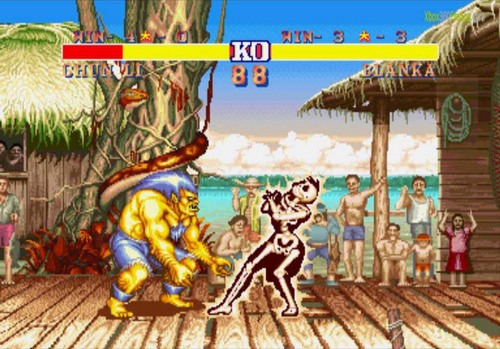Now, let’s fast-forward to the present. We have the luxury of online connectivity which enables to download content for a game, play with friends online, and receive patches and updates. One would think that yearly revisions and sequels would disappear after the adoption of the online means of distribution. After all, patches and updates could be downloaded at any time the developers make it available and characters can be bought as downloadable content. Even major revisions and changes can be made a product and sold digitally cutting down on costs to physically release a new game. Why is it then that we still have frequent revisions of games?
Blazblue is one example and is criminal to these practices. Blazblue made its debut in 2009 for the Xbox 360 and the PlayStation 3. Since then the game has seen an annual release with the exception of 2011, though this is debatable since it was released for portable systems rather than consoles. You can easily argue that Blazblue’s sequels require physical releases rather than digital because of the great many changes that alter the interface, gameplay, and features entirely, however, you can easily argue that they should’ve created a game that can easily adopt these changes through online distributional means.

Personally it’s annoying that I have to buy a new version of the game every year. Luckily Aksys Games have made it cheap by making the subsequent versions of Blazblue $40, compared to the $60 that games normally retail for. Even so, it’s baffling to me that that the developers, or publishers, opted to not release these yearly updates/revisions for a low price online. A few new characters, updated moves, some feature changes, charge it for a measly $20 or $30 dollars and you’re good to go! This easily sets apart a revision from a proper sequel or a title that could fall under that category. Revisions would be minor alterations of the game and with a bit of new features. Sequels would be departures from the previous releases adding in all the things that revisions do as well as a gameplay overall or perhaps drastic changes.
Blazblue currently has three proper major titles: Calamity Trigger, Continuum Shift, and the just announced Chrono Phantasma. Among these are two revisions Continuum Shift II and Continuum Shift Extend. These revisions aren’t a big departure from each other. Some patches that balances characters and new characters that were introduced as DLC were the gist of these releases. It’s odd then that it would be fitting for a physical release rather than an update. Perhaps this an easy cash grab as well as to get attention for those who don’t know about the franchise but even so, I find it somewhat insulting that they expect me to pay large sums when they have alternatives available. Now, while US players are a bit lucky and get the $40 versions of the game, the Japanese players aren’t. Although they may be revisions, often times they will pay the same price across the board for all revisions and sequels. They have it particularly rough, so we should count ourselves lucky.

My main problem with all these releases of sequels and revisions on an annual basis is that it’s hard to distinguish what truly is a revision and a sequel and what changes exactly warrant a great price point. Everything becomes gray and starts to mold together making it hard to distinguish what exactly we are paying for. Essentially, we become pawns in a way because game companies are pushing to see how little they can put into the game and charge a large sum of money. It also brings up the idea where game developers can remove or keep certain aspects of the game out for a possible revision in the future, which is possibly what happened with Marvel vs. Capcom 3.
If you have the money you probably wouldn’t complain about these things. Even if money wasn’t the main issue, I still think this is an important issue to bring up because we could possibly see situations where revisions occur a lot more often they should and possibly be charged an absurd amount of money for it. So what’s the basic take on the idea of the crazy revision sequel situation? Let’s just get rid of the physical release of revisions and keep it online, keep sequels and major releases as physical releases, and keep everything simple.
Normally I take the time on Nitpick to discuss something that annoys me in video games. My last Nitpick was a little different because rather than complaining, I praised Journey and Splinter Cell for doing something amazing. I’m back to nitpicking this week but rather than a mechanic in a video game, I want to complain about a practice that has recently taken root in video games, particularly in the fighting genre.

Before I begin, I’d like to note that I love fighting games. I’m actually quite horrible at fighting games but I consider myself to be a big fan of the genre, after all I own a Tournament Edition Fightstick which isn’t all that cheap. There’s just something awesome about beating someone in a one vs one match with crazy moves, supers, combos, and more. However, it’s more about the flash. Fighting games require intricate input motions – especially if you’re using a fightstick- and there are subtle nuances that create the mechanics and systems in a game that sets the best players from the rest. You know that having perfect block strings will get you easily countered and those that know how to do mix-ups, cross-ups, and counters will easily pummel you to defeat. All of these things are what create the thrill of fighting games. It’s just simply awesome.
However, if fighting games are so great what exactly is so bad about them? Let’s wind the clock back almost a decade ago before the advent of online playspace. Fighting games were aplenty. Titles such as Street Fighter, Tekken, Guilty Gear, Dead or Alive, Mortal Kombat and Virtua Fighter are some of the most prominent in the genre. Although they all fall under the same genre roof, they played drastically different from each other. Dead or Alive is more about direct counter moves and reversals for combat while Guilty Gear featured more on sprite-based frame combat. Each franchise brought something entirely new to the mix.

Despite being different they all adopted a common notion: sequels and revisions. This isn’t something that is rare. Every year or two, or sometimes even later, developers opt to release a new version of the game. For example, games such as Guilty Gear has a dozen versions of the game. There are in actuality three primary releases of the game but in between each of these titles there are the inevitable revisions that require purchase. In these revisions are perhaps new characters, slight tweaks of character moves which would either nerf or buff the, and a possible system tune-up. The same situation could easily be applied to Street Fighter and other titles as well. It’s a common practice, especially in Japan, due to fighting arcade games being a very popular activity.
Revisions and sequels that come out yearly are justified. It changes up the dynamic of the game and attracts new players as well as veterans that might’ve gotten bored over a period of time. For fighting games, any minor change can greatly affect the game on a large scale. Despite it being revisions and sequels, there was no particular way to simply update your game so players would have to purchase the newer versions.










